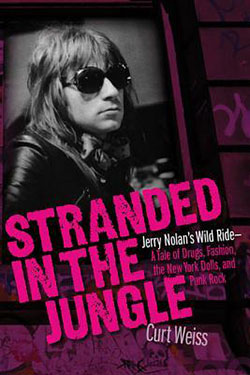“Stranded in The Jungle” is solidly researched and referenced with input from many of Nolan’s friends, lovers and associates during his storied, roller coaster ride. Notably absent is Jerry’s final partner, Phillis Stein, and that might be understandable given personal issues connected with the state of Nolan’s health in his final years.
This is the story of a kid from Brooklyn whose formative years were spent in flux. His family moved to Hawaii and then Ohio, his father splitting and leaving an emotional hole. It’s simplistic to say that we know how Jerry filled that hole. It is revealing that Nolan himself fathered a son, who he and his then-girlfriend fostered out.
One seminal event is his mother Charlotte taking him to watch master drummer Gene Krupa through the window of a downtown New York City club. It’s impossibly to underplay the impact seeing, meeting and striking up a friendship with Krupa on a nascent Jerry Nolan. Once Nolan hit his straps in the latter-day Dolls and the Heartbreakers, he had no peer in rock and roll. Much of the reason lies in the influence of jazz.
Weiss doesn’t fear to tread on ground others might choose to avoid. Nolan is painted as a lifelong user of women to procure whatever he wants, occasionally resorting to violence. He’s portrayed as overtly racist, a homophobe and surprisingly insecure.
More than one person from Nolan’s past is happy to put in the boot - Heartbreakers manager, the late Leee Black Childers, is especially scathing and they remained estranged until near the end. Nolan’s famously complicated relationship with Johnny Thunders is painted in some detail.
Most telling is the impression that, like many smack addicts, he didn’t want to stop. Most disturbingly, he was quick to encourage others to take it up. One was Glen Matlock, touring Australia with Thunders and Nolan in 1987. It did northing for him. Others, like his Swedish ex-wife Charlotte Lotten, weren’t so easily deterred.
On the flip side, Jerry’s obsessive sense of style (“profiling”) was highly influential. Women found that, and his sense of apparent vulnerability, irresistible. The best dressed rocker with the nicest looking chicks. A rock star.
The dominant take-out is of someone who had his chances at the big time, blew them and knew it. The New York Dolls could have been superstars. The Heartbreakers should have been the greatest band to come from punk. Both crashed and burned. Peter Criss of KISS was a teenage friend and his meteoric rise to fame was in sharp contract to Nolan’s, a point that seemed to become an obsession.
There are plenty of revelations in “Stranded…” and it’s a gripping ride, even knowing the final destination. It fills many gaps and is an important work in the context of New York punk.


 The cover does not lie. It was a wild ride for Jerry Nolan, drummer from the New York Dolls and Johnny Thunders and the Heartbreakers. And it’s all outlined in detail in Kurt Weiss’s gripping, 310-page biography.
The cover does not lie. It was a wild ride for Jerry Nolan, drummer from the New York Dolls and Johnny Thunders and the Heartbreakers. And it’s all outlined in detail in Kurt Weiss’s gripping, 310-page biography.